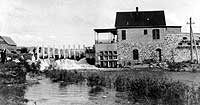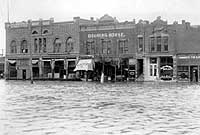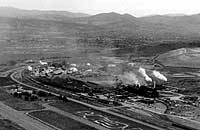
|
Page
128
|
 |
| Pocatello Power and Irrigation Company dam, looking south after 1899. The mill building still stands on the corner of North Johnson and West Wyeth Street where a footbridge crosses the river. Bannock County Historical Society Collection. |
Hydroelectric
Power
In 1892 Daniel Swinehart
built a 60 kw power plant and mill at 1000 N. Grant, near Irving Junior High
School. The power house in the picture below was built in 1899, and owned by
the Pocatello Power and Irrigation Company. It was located at the corner of
West Wyeth and North Johnson, and had a capacity of 100 kw. The dam backed up
a reservoir in the area of the present Memorial Building which was a park, and
used for skating in the winter. The Rainey Park area was also flooded and the
ice harvested for refrigeration. In 1902 the power plant was sold to the American
Falls Power, Light and Water Company. In 1915 all power companies were acquired
by what was to become Idaho Power Company, and operations were moved to the
Snake River at American Falls. In 1926 the American Falls Dam was built.
 |
| Flood on the east side of the 100 block of South First Ave., January 1911, caused by a rapid thaw and rainstorm. The floodwaters came west from the hills at the head of Center Street. The Phoenix Building is on the corner of South First and Center Street. The Rooming House south of it became the Porters and Waiters Club, which was owned by a black man and one of the only places that transient blacks could stay in Pocatello at that time. Bannock County Historical Society Collection. |
Floods
in the Portneuf Valley
The Portneuf
River, occupying the channel of the Bonneville Flood, and following the path
first carved by Bear River, in summer is quiet, muddy, and easily waded. However,
it has repeatedly flooded the downtown Pocatello area. The floods have been
caused either by heavy winter rains in January and February on snow-covered
and frozen ground, or by high runoff of the melted snow pack in May. After two
successive February floods, in 1962 and 1963, Pocatello City and Bannock County
requested the help of the U.S. Army Corps of Engineers. The Corps designed and
built (in 1965) the concrete flood control channel which now winds through the
west side of downtown Pocatello.
This channel, functional though it may be, is a scar on the tree-lined neighborhoods of the west side and an albatross around the image of Pocatello as a beautiful city nestled against the southeast Idaho mountains. The open sewer or river channel remains, stark, fenced, and sterile, but it cannot be easily removed, since it belongs to the U.S. Government, was built to highest engineering standards, and does an excellent job of controlling floods.
 |
| Aerial view, looking east, of the phosphate plants west of Pocatello. The FMC elemental phosphorous plant is in the foreground with the J.R. Simplot Company phosphate fertilizer plant (with the white domes) in the background. Waste products or "slag" from these plants were used until the 1990s to surface the streets of Pocatello. This practice was stopped because of concerns over health hazards related to the higher than normal background content of radioactive minerals in the slag, (July, 1990). |
Pocatello:
Idaho's Industrial City
Pocatello
located at the mouth of Portneuf Narrows for reasons of transportation, and
has always been a transportation and industrial center. It remains, in 1996,
the only truly industrial community in Idaho. Processing plants using phosphate
rock from the mountains to the east employ hundreds. Many light industries are
found in Pocatello, serving all of eastern Idaho. There is still a sizable blue
collar work force.
Pocatello is also unique in that it has ethnic communities who have lived there for many decades. These groups came with the railroad, and stayed through labor disputes and layoffs, and now serve to make Pocatello ethnically and racially diverse, another anomaly in Idaho.
Reflecting this blue collar and ethnic population base, Pocatello generally has elected Democrats to the State Legislature although the area outside Pocatello and indeed most of the state is traditionally strongly Republican. This political fact has contributed, in recurrent manner, to the general fact that in Idaho, Pocatello and Idaho State University get State programs last.